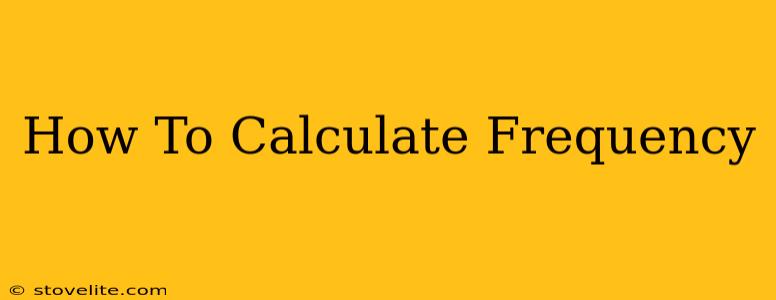Understanding frequency is crucial in various fields, from physics and engineering to music and data analysis. This comprehensive guide will walk you through different methods of calculating frequency, depending on the context. We'll cover everything from basic calculations to more advanced techniques, ensuring you have a firm grasp of this fundamental concept.
What is Frequency?
Before diving into calculations, let's define frequency. Frequency is a measure of how often something occurs within a given period. It's typically expressed in Hertz (Hz), which represents one cycle per second. The "something" can be anything that repeats, such as:
- Waves: Sound waves, light waves, radio waves, etc.
- Oscillations: The back-and-forth movement of a pendulum or a spring.
- Events: Occurrences of a specific event within a timeframe (e.g., website visits per hour).
Calculating Frequency: Basic Methods
The simplest way to calculate frequency is if you know the number of occurrences and the time period over which they occurred. The formula is:
Frequency (f) = Number of Occurrences (N) / Time (t)
Example 1: Calculating the frequency of a wave
Let's say a wave completes 100 cycles in 5 seconds. The frequency would be:
f = 100 cycles / 5 seconds = 20 Hz
Example 2: Calculating event frequency
A website receives 500 visits in one hour. The frequency of visits per minute would be:
f = 500 visits / 60 minutes = 8.33 visits/minute
Calculating Frequency from Period
Sometimes, instead of knowing the number of occurrences, you know the period (T), which is the time it takes for one cycle to complete. In this case, the formula is:
Frequency (f) = 1 / Period (T)
Example 3: Calculating frequency from period
A pendulum takes 0.2 seconds to complete one oscillation (its period). Its frequency is:
f = 1 / 0.2 seconds = 5 Hz
Calculating Frequency in More Complex Scenarios
In more complex scenarios, calculating frequency might involve:
- Using Fourier analysis: This mathematical technique is used to decompose complex waveforms into their constituent frequencies. It's widely used in signal processing and analyzing data with multiple frequencies present simultaneously. Software tools like MATLAB and Python libraries (e.g., NumPy, SciPy) are often employed for this.
- Measuring with specialized equipment: Instruments like oscilloscopes, frequency counters, and spectrum analyzers are used to directly measure frequency in various applications, from electronics to telecommunications. These instruments provide highly accurate frequency readings.
Practical Applications of Frequency Calculation
Calculating frequency has numerous applications across various domains:
1. Acoustics and Music: Frequency determines the pitch of a sound. Higher frequencies correspond to higher pitches.
2. Electronics and Telecommunications: Frequency is fundamental in radio waves, microwaves, and other electromagnetic signals. Knowing the frequency allows us to tune into specific radio stations or channels.
3. Data Analysis: Frequency analysis helps identify patterns and trends in data, such as website traffic or customer behavior.
4. Physics and Engineering: Frequency is key to understanding vibrations, oscillations, and wave phenomena in numerous physical systems.
Conclusion
Understanding how to calculate frequency is a valuable skill with broad applications. This guide has provided a foundation for basic calculations and pointed towards more advanced techniques for dealing with complex scenarios. By mastering these methods, you'll be equipped to analyze and interpret data involving repetitive phenomena in many different fields. Remember to always consider the units (Hz) when expressing frequency.

